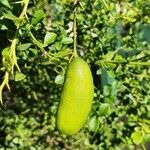Shrub or small tree to 10 m high; spines 5–12 (–25) mm long, solitary. Leaves: petiole 1–3 mm long, not winged, articulated with lamina; lamina obovate to rhomboid, 22–25 (–50) mm long by 14–15 (–25) mm wide (smaller and ovate in young plants), truncate at base, obscurely toothed in upper half, truncate or emarginate, glabrous. Flowers solitary or paired, male (mostly) and bisexual, (3–) 5-merous; Petals oblong, (6–) 7–8 (–9) mm long, white. Stamens 20–25, free. Ovary 5–7-locular, each locule with 8–16 ovules. Fruits cylindric-fusiform, often weakly falcate, to 50 (–100) mm long and (15–) 20 (–25) mm diam.; pericarp rough, greenish yellow; mesocarp yellow. Seeds many per locule, ovoid, 6–7 mm long; embryo solitary.



